
Harrogate is a spa town in the district and county of North Yorkshire, England. Historically in the West Riding of Yorkshire, the town is a tourist destination and its visitor attractions include its spa waters and RHS Harlow Carr gardens. 13 miles (21 km) away from the town centre is the Yorkshire Dales National Park and the Nidderdale AONB.

Knaresborough is a market and spa town and civil parish on the River Nidd in North Yorkshire, England. It is three miles east of Harrogate and was in the Borough of Harrogate until April 2023.

The Harrogate line is a passenger rail line through parts of North Yorkshire and the West Yorkshire area of northern England connecting Leeds to York by way of Harrogate and Knaresborough. Service on the line is operated by Northern, with a few additional workings by London North Eastern Railway starting and terminating at Harrogate. West Yorkshire Metro's bus and rail MetroCard ticket is available for journeys between Leeds and Harrogate.

Harrogate and Knaresborough is a parliamentary constituency in North Yorkshire which has been represented in the House of Commons of the UK Parliament since 2010 by Andrew Jones, an MP from the Conservative Party. The constituency was formed in the 1997 boundary changes, before which it was named Harrogate.

Nidderdale, historically also known as Netherdale, is one of the Yorkshire Dales in North Yorkshire, England. It is the upper valley of the River Nidd, which flows south underground and then along the dale, forming several reservoirs including the Gouthwaite Reservoir, before turning east and eventually joining the River Ouse.

Starbeck is a railway station on the Harrogate Line, which runs between Leeds and York via Harrogate. The station, situated 18+1⁄4 miles (29 km) west of York, serves the village of Starbeck, in North Yorkshire, England. It is owned by Network Rail and managed by Northern Trains.

Spofforth is a village in the civil parish of Spofforth with Stockeld in the Harrogate district of North Yorkshire, England, about 3 miles (4.8 km) north west of Wetherby and 5 miles (8 km) south of Harrogate on the River Crimple, a tributary of the River Nidd.

Killinghall is a village and civil parish in the Harrogate district of North Yorkshire, England. The civil parish population taken at the 2011 census was 4,132.
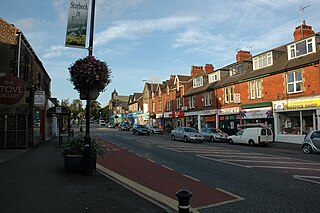
Starbeck is a village and suburb of Harrogate in North Yorkshire, England. The population of Starbeck Ward taken at the 2011 census was 6,226. It has many facilities, including Starbeck railway station, which serves the Harrogate Line.

Milby is a hamlet and civil parish in North Yorkshire, England. It is situated to the immediate north of Boroughbridge.
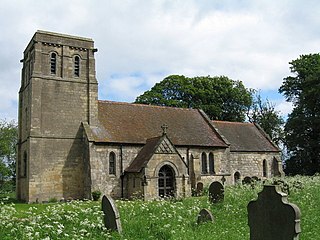
Moor Monkton is a village and civil parish in the former Harrogate District of North Yorkshire, England. It is situated on the River Nidd and 7 miles (11 km) north-west from York city centre.
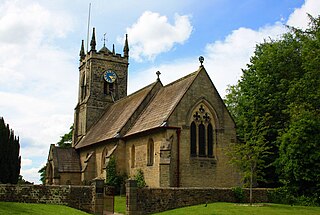
Nidd is a small village and civil parish in the Harrogate district of North Yorkshire, England. The population of the village taken at the 2011 census was 168. It is situated 3 miles north of Harrogate, 1.2 miles (2 km) east of Ripley on the B6165 Pateley Bridge to Knaresborough road and near the River Nidd. The village used to have a railway station on the Leeds to Northallerton Railway, but this was closed down on 18 June 1962.
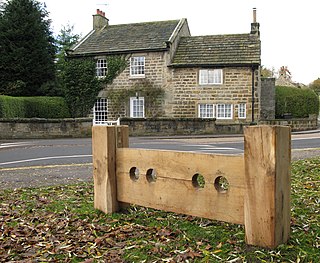
Pannal is a village in the Harrogate district of North Yorkshire, England. Historically part of the West Riding of Yorkshire, it is situated to the immediate south of Harrogate. Since 2016 it has formed part of the new civil parish of Pannal and Burn Bridge. The village is served by Pannal railway station on the Harrogate (Railway) Line between Leeds and York.

Nidd Gorge makes up a section of the River Nidd in North Yorkshire, England, in which the river enters a deep ravine with sheer tree-covered valley sides. The river as a whole flows from its source near Great Whernside in Nidderdale, to its confluence with the River Ouse near Nun Monkton. Nidd Gorge makes up approximately 3 miles (4.8 km) of the entire length of the river, and stretches from the now defunct Nidd viaduct at Bilton in Harrogate to Grimbald Bridge, just south of Knaresborough.
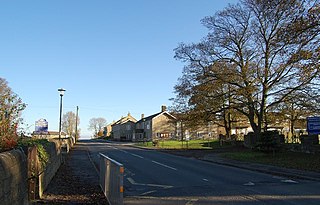
Burnt Yates is a village in the Borough of Harrogate in North Yorkshire, England.

The Nidderdale Greenway is a 4-mile (6.4 km) path that runs between Harrogate and Ripley in North Yorkshire, England. It uses a former railway line that ran between Harrogate and Pateley Bridge as its course. The route connects to other cycle paths including the Way of the Roses.

Knaresborough Viaduct is a viaduct in the North Yorkshire town of Knaresborough, England. The viaduct carries the Harrogate line over the River Nidd in the town. The viaduct was supposed to have opened in 1848, but the first construction collapsed into the river very near to completion, which necessitated a new viaduct and delayed the opening of the line through Knaresborough by three years.
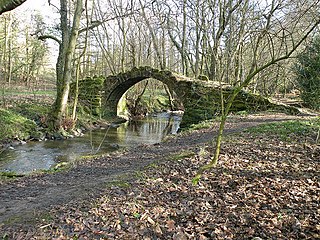
Oak Beck is a watercourse that flows eastwards across the northern part of Harrogate in North Yorkshire, England. The beck flows through a broad V-shaped valley, before emptying into the River Nidd at Bilton, just upstream from the Nidd Gorge Viaduct. Water from Oak Beck has been used as a water supply for Harrogate and also for industrial purposes further downstream.
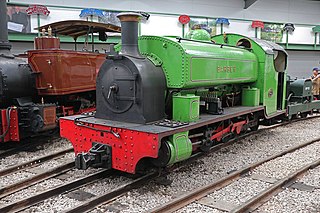
Harrogate Gasworks Railway was an industrial railway in the town of Harrogate, North Yorkshire, England. It was built to the gauge of 2 ft and ran between Bilton Junction on the North Eastern Railway, to the Harrogate Gas Company's (HGC) works at New Park, north of the town centre. It opened in 1908 to carry coal to the works for gasification, and outbound byproduct liquids. It closed to traffic in 1956. The railway was noted for its tight gauge restrictions in the tunnel at New Park. Two of its steam locomotives have survived into preservation, and are still in use on heritage railways.





















